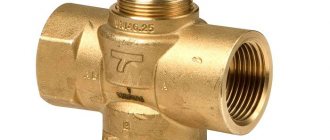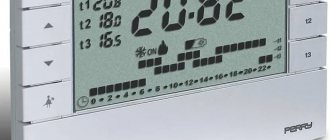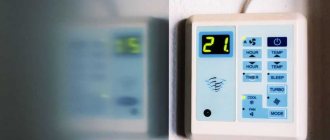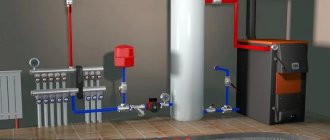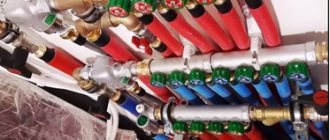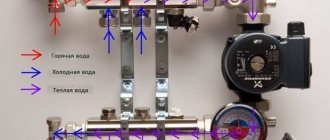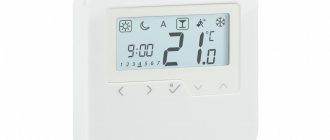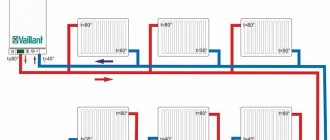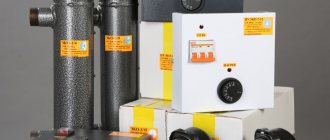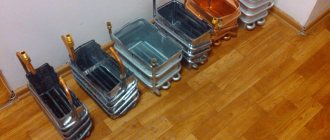In private homes, the main source of heat is a heating boiler. In order to control the heating process of the equipment, a temperature sensor is needed for the heating boiler. It is on its normal operation that both the comfort throughout the house and the safety of the heating equipment largely depend.
Design and principle of operation
Heating boilers can be supplemented with temperature sensors, both internal and external (remote).
The built-in ones are responsible for adjusting the heating installation depending on the temperature of the liquid inside the heating system.
External ones help to adjust the operation of the heating installation in accordance with the readings of either room or street temperature. The joint use of a pair of such sensors makes it possible to more accurately regulate the operation of the boiler installation, which means there is energy saving when weather conditions change.
The operation of the devices consists of constant measurement of processes:
- resistance;
- pressure;
- thermal expansion.
Which are in direct connection with the temperature of the heating system filler.
Automatic thermostats work according to the program embedded in them, controlling the operation of heating devices.
Mechanical controllers, when exposed to high temperatures, are capable of changing their thermal conductivity by closing/opening the connections of the corresponding valves.
All temperature sensors are placed in a special, small-sized block housing with installation directly into the heating structure.
The results obtained can be transmitted over a wireless communication channel, such as WI-Fi, or transmitted over wires.
Both electric and solid fuel boilers can be controlled by temperature sensors.
The programming function using a thermal relay paired with temperature sensors allows you to automate the procedure for adjusting the heating system. In addition, this makes it possible to significantly reduce heating costs.
In general, the entire structure can be equipped with three temperature monitoring devices:
- Indoor.
- Street.
- For water-based underfloor heating systems.
Pros and cons of room thermostats
A thermostat for a heating boiler is just a convenient addition that provides temperature control and control of various service functions. This device is not a mandatory component of the heating system; in some cases you can do without it. A room temperature regulator is convenient in large households and multi-room apartments, when the boiler may be located too far away - in this case the temperature can be adjusted, for example, from the living room.
Let's look at all the advantages of a thermostat for a heating boiler:
Once you set up such a device, you can enjoy a comfortable temperature in your home for a long time.
- Ensures compliance with the specified temperature regime - you can create a comfortable environment in your apartment or house without additional effort;
- Automation of the heating system - the programming function is responsible for this;
- The use of a thermostat will reduce gas consumption by the heating boiler - thereby achieving savings on utility bills.
Unfortunately, there are some drawbacks:
- A wired room regulator for a gas boiler requires laying a cable - this is easier to do at the stage of building a house than laying it on top of the repairs made;
- Cost of equipment – advanced thermostats are quite expensive. Otherwise, you will have to do without additional functions.
The shortcomings are not the worst, so you can put up with them. After all, you have to pay for convenience.
Classification of types of temperature sensors
In order to choose the right boiler temperature sensor, you need to know where it (temperature) will be controlled:
- from inside the boiler plant;
- ambient air temperature in the rooms;
- coolant inside the heating structure itself.
The correct installation location of the meter affects not only the efficient operation of boiler equipment, but also the safety of its use.
There are two main criteria by which the temperature sensor is selected correctly:
- How is temperature determined?
- How the sensor interacts with the thermostat.
Types of sensors by method of determining temperature
There are several ways to measure temperature:
- Dilatometric. It is directly dependent on the state of the bimetallic plate with a large coefficient of thermal expansion, which can expand under the influence of heat. Magnets specially placed inside increase the sensitivity of the sensor.
- Thermoelectric. It consists of a pair of dissimilar conductors, which, during thermal expansion, are capable of producing thermo-emf. It is distinguished by increased accuracy due to the fact that the length and cross-section of the cables do not have a significant impact on the measurement result.
- Manometric. They measure how much the state of liquids or gases in a certain limited volume changes when heated.
- Resistive. Special alloys with high thermal expansion are used. They are sensitive to the slightest temperature changes. Usually presented in the form of a coil with copper-plated wire, placed in a plastic case.
- Semiconductor. Available in two versions:
- nonlinear temperature thermistors with a simultaneous decrease in resistance when heated;
- posistors with a nonlinear dependence, which is expressed in an increase in the resistance coefficient when heated.
Types of contact sensors
A special temperature sensor for the boiler can be connected to the equipment in two ways:
- using wires through which temperature data is transmitted to the control controller;
- using wireless technology. They operate on a dedicated radio frequency.
But it should be taken into account that there are no miniature wireless devices for heating systems. To power the device, read information and simultaneously transmit a signal, a control controller is required. Therefore, a wireless thermostat can only be paired with a room sensor. And the temperature sensor itself is for small-sized boiler equipment.
Types of control devices
Thermostats for heating boilers with the option of temperature control are divided into several types:
- mechanical models with one function;
- programmable models with a large range of auxiliary settings.
Wireless models
Also, similar designs are wireless and wired. Thermostats are installed in the selected location, a temperature sensor is connected and connected to the control device.
Design diagram of the control device
Note! Thermostats must be provided with constant air access to prevent overheating. It is also not recommended to install electrical appliances nearby.
Selecting a room programmable device
The option of an electronic temperature sensor for a heating boiler helps you select the appropriate temperature mode and change it at your discretion. The room thermostat sets the set values every day. Some setpoint values can be programmed, for example when day turns to night.
Such controllers have additional options. For example, a function that allows you to stop heating for a while and then resume it. You can also change the programmable temperatures for the duration of the configured periods. Another useful option is the ability to change the heating intensity.
Room type regulator
Thermostat as a central element
The central thermostat for the heating boiler (temperature regulator) is located at a certain distance from the heating unit and allows you to turn off and turn on equipment throughout the house.
Installation diagram of thermostats in the heating system
Related article:
Thermostat for heating radiator. What task does this device perform and what is its advantage? What is the operating principle and correct installation? Prices also matter. More details in a special publication.
Models from previous years are connected directly to the heating unit by wires, while more modern designs are distinguished by remote control. The latest devices are mounted in dual-circuit units Beretta, Ferroli and AOGV. Room control mechanisms for boilers of the Protherm and Gsm brands are popular. They differ in their dilatometric mechanism.
Protherm equipment models
Room devices stop heating when necessary. They monitor the air temperature and turn on the heating when the temperature drops. The best place for a microcontroller is considered to be the bedroom and living room.
Installing a controller will allow you to obtain accurate data on the microclimate of the room
Helpful information! The recommended temperature for the thermostat is 20 degrees, and in the children's room - 21-22 degrees. At night, the temperature can vary from 19 to 21 degrees.
Thermostatic valves for regulation
Such a device allows you to create a certain coolant temperature by mixing the forward and return flows. The device helps control temperature values by changing the flow of hot water through the battery. In this case, the mechanism controls the supply of hot water through the battery, but not through the boiler. It is installed in any room where you need to maintain a certain temperature.
Thermostatic valve design using the example of a specific model
Where can I buy
Electronics for heating boilers are available for purchase in specialized stores in your city. But there is another option that has recently received significant improvements. You no longer need to wait a long time for a parcel from China: the AliExpress online store now offers the opportunity to ship from transshipment warehouses located in various countries. For example, when ordering, you can specify the “Delivery from the Russian Federation” option.
Follow the links and choose:
| Thermostat for gas boiler with Wi-Fi and remote control, 3A | Smart Wi-Fi thermostat Tuya for boiler | Smart Wi-Fi Touch Thermostat, Wireless |
| Digital LCD Thermometer with Water Temperature Gauge | Thermostat for gas boiler TUYA, wireless | Intelligent Thermostat, Temperature Controller |
Why do you need a stabilizer for an electric boiler?
A voltage stabilizer is an automatic device for electric heating boilers, which, like a thermostat, allows you to save money. But in this case, we are not talking about efficient energy consumption, but about the integrity and performance of the heating element as a whole.
A stabilizer for an electric heating boiler allows you to smooth out all differences in the operating characteristics of the electrical network during the day and obtain the correct sinusoidal voltage at the output, which will have a beneficial effect on the durability of the boiler. Stabilizers provide a high degree of protection of electrical appliances from ripple and voltage surges. High-quality equipment is highly sensitive, which is important for the electronic part of the boiler and thermostat. Stabilizers are characterized by an increased margin of network output power. This allows you to maintain the operating characteristics of the electrical network at the proper level even when the boiler is turned on.
Before purchasing a stabilizer, you must consult a specialist and clearly determine the type of equipment needed and its power.
Placements
Naturally, the sensor must be placed in the zone of influence of the heater. Therefore, they are distinguished by the method of placement:
- overhead - installed with tight contact directly on the heated surface;
- submersible - placed inside the coolant;
- room - the room temperature is controlled;
- external - the state of the external environment outside the house is measured. They have a waterproof body.
The sensor controls the boiler
In order to more fully ensure comfortable living in a house with a minimum of thermal energy consumption, various devices are used. Such a temperature sensor for a gas boiler allows it to be programmed for different operating modes. The user just has to set the necessary parameters.
Mechanical thermostats
These models are the simplest. Without extensive functionality. They work through the use of membrane sensors located in a sealed capsule filled with liquid. When heated, the liquid expands and at a certain temperature puts pressure on the membrane and the thermostat makes it clear to the heating boiler that the power can be reduced/increased.
Mechanical devices are equipped with an expressive temperature selection dial. Due to their 3-4° accuracy and the wired connection method, these regulators are inexpensive.
Electromechanical
A slightly improved version of the previous temperature controller - electromechanical devices.
The principle of temperature regulation is similar to mechanics, but the operating principle is slightly different. The design uses heat-sensitive metals. When the heating changes, a micro-discharge is created or the resistance changes.
There are models with a small display for heating control and the possibility of adjustments in reduced steps. These changes were reflected in a slight increase in the accuracy of the device and in its price - it became more expensive than mechanics.
Electronic
More accurate electronic models are the most popular. These are more modern thermostats. They are multifunctional and easy to use.
- Can be used in conjunction with underfloor heating temperature sensors.
- Possibility of programming.
- There is protection against overheating and freezing.
- Warns that the circulation pump has stopped working.
- The measurement error is within 0.5–0.7 °C.
More advanced versions are equipped with built-in Wi-Fi for wireless connection to the boiler. Such a wireless room sensor, despite its high price, has a short payback period if used correctly.
Prices for thermostats of different models
The cost of thermostats for heating boilers depends on the type of device, the number of supported functions and the manufacturer. The most advanced models of programmable thermostats with a large selection of settings will cost much more than models of simple mechanical devices, however, their level of accuracy is much higher.
When choosing one or another type of device, it is worth considering the level of energy saving that it can provide to the heating device and the degree of ease of control of the equipment to achieve a comfortable indoor climate. The approximate price of a mechanical thermostat for a Baxi heating boiler with a temperature setting range from 5 to 30°C and frost protection is 1,180 rubles.
It is recommended to choose a thermostat and boiler from the same manufacturer, this will ensure uninterrupted operation of the entire system.
You can buy a room thermostat for a mechanical gas boiler, model SAS816WHB-0, with a 5-minute response delay option for RUB 1,490. A special feature of this device is the ability to control not only the operation of gas heating equipment, but also the operation of the air conditioner. A room mechanical thermostat Cewal RQ10 will cost you 790 rubles.
The estimated cost of an electronic wireless thermostat for the Salus Controls 091 FLRF boiler is RUB 5,200. The functions of the device include two heating modes (economical and comfortable), setting weekly programs, three levels of temperature control, 9 heating system control programs. You can buy a thermostat for the solid fuel boiler AURATON S14, which is a multifunctional device, at a price of 6,700 rubles.
By purchasing a thermostat for a heating boiler, you can not only set a comfortable temperature for each room during the cold season, but also extend the life of your heating equipment.
How to choose a remote temperature sensor
What to look for when buying a temperature sensor? There are several options:
- A temperature meter needs extreme sensitivity and a wide range of measured temperatures. To quickly respond to changes in heating;
- sensor type - submersible or external. Is there a place for installation? It must match the dimensions of the water heater;
- temperature sensor parameters. Is there a need for additional voltage? At what speed is the signal transmitted and with what error. Ability to work in the right conditions;
- service life, maintenance frequency, need for additional calibrations;
- output signal level;
- permissible current, resistance, etc.;
When going to the store to buy a new device, it is better to take with you the technical data sheet for the heating installation.
Paired with thermostat
See how the temperature sensors will work with the boiler - with thermostat support or directly.
Many modern thermostats have the ability to adjust heating control depending on the weather. In this case, the power of the heating installation can be adjusted automatically if the thermostat is paired with an outdoor temperature sensor.
An outdoor thermostat is a single structure consisting of the sensor itself and a long (2–6 meters) wire for connection to the thermostat.
Should be considered:
- in what temperature range can the sensor for a gas boiler operate;
- level of moisture protection;
- the magnitude of the error in indoor air measurements. Permissible ± 1 °C. Good ± 0.5 °C;
- connecting cable length. Out of the box there is a wire up to 6 meters long with an attached temperature sensor.
Direct connection to the boiler
As a rule, those boilers that are purchased are already equipped with temperature meters and they are developed by the same supplier. If you want to install remote control of the boiler using a controller, you need a cable (usually two-wire). But you need to buy it yourself. The wire cross-section and resistance can be found in the instructions for the sensor.
They are usually connected to a thermostat. When automatically controlling the operation of boiler equipment, the connection is made to the controller, which brings the boiler to operating modes.
In any case, the connection is strictly regulated, according to the attached instructions.
Additional control devices, if necessary, can be recommended by the manufacturer of the boiler apparatus. This way you can guarantee the compatibility of devices and their correct operation.
If at the time of purchase the factory-recommended sensor for a gas boiler is not available, it must be replaced with certified analogues.
Outdoor sensor connection
An outdoor temperature sensor for boiler equipment is mounted on the outside of the building wall, subject to the following conditions:
- the temperature sensor should not be directly heated by the sun;
- the wall of the premises building should not be sheathed with metal;
- exclude the laying of cable lines in places where there is a possibility of rainfall;
- avoid contact with chemicals that may damage the insulation;
- the maximum height for placing a temperature sensor is 2/3 of the height of the house;
- exclude the influence of extraneous factors that may affect the external temperature sensor.
- protect the wire with an additional corrugated tube;
An external temperature sensor is connected, observing the polarity, when the boiler is not supplied with power. The main condition is that the cable with a cross-section of 0.5 mm² must be solid, and the length should not exceed 30 meters. The places where the cable is connected to the boiler and the meter must be insulated and sealed.
After connection, the quality of installation work is checked and the thermostat is adjusted. Additional inspection may reveal errors. In this case, a complete rework is required. Improper installation of an outdoor sensor can lead to either failure of the boiler equipment or poor heating of the premises.
Connecting the sensor inside the building
A room temperature sensor for a gas boiler is installed from the inside of the room on the outer wall, without violating the following conditions:
- Avoid being near heaters or air conditioners.
- Free access to the interior space. Eliminate all interior items that obscure the room sensor.
- The permissible height is 1.2–1.5 meters from the floor.
- There should be no nearby electrical wiring.
The method of connecting the device to boiler equipment is similar to an external temperature sensor.
Connecting a temperature sensor for a gas boiler
The temperature sensor for the gas boiler must be installed on the controller itself. As an option, installation on a gas valve is allowed.
Sequence of actions for self-connection:
- The instructions for the gas boiler must include a diagram. It contains the heating boiler itself and the place where the device is connected, its markings and the location of the contacts.
- Now on the gas heater itself you need to remove the front panel. It blocks access to the board and contacts.
- You need to remove the factory jumper between the terminals.
- Connect the wires from the sensor contacts to these terminals. The polarity of the wires does not matter.
- If a wireless air temperature sensor is installed to the relay unit, connect a three-wire wire with 220 V grounding.
If there are any doubts about the correct installation, it is recommended to refer again to the instructions for the gas boiler.
Types of thermostats for boilers
The main difference between thermostats is different types of temperature-sensitive sensors. Some are installed on the heating pipe, others inside it, and others are mounted on the wall. Some are designed to measure air temperature, and the second - coolant.
The choice of thermostat model depends on:
- boiler type;
- heating system wiring diagrams;
- availability of free space;
- required functionality.
Many modern boilers are pre-designed to connect thermostats to them. Moreover, the manufacturer of boiler equipment immediately writes down all the nuances of this installation in the technical data sheet.
If an electronic thermostat model is selected, then it is best to give preference to the most efficient one - the one recommended by the boiler developer
Ideally, the thermostat should regulate the operation of the heating device itself, that is, the supply of fuel to it. This is the most efficient connection scheme in terms of fuel economy. In this case, the energy carrier will be burned exactly as much as the heat required.
But such a thermostat can only be installed on a gas or electric heating unit. If the boiler is solid fuel, then a thermostat with a mechanical valve, which is mounted on the pipe, will help regulate the room temperature.
Regulators installed on batteries are designed to shut off the water supply if the temperature in the room or coolant is too high. In this case, the boiler stops working a little later, when its own temperature sensor inside is activated, preventing overheating of the equipment.
Group #1: mechanical
The operation of a mechanical temperature sensor is based on a change in the characteristics of a material when its temperature changes. This is an easy-to-use, budget-friendly, fairly effective and completely power-independent option. It is designed for installation on pipes of a water heating system to regulate the flow of coolant.
A classic example of a mechanical thermostat is a device with a needle valve (constipation) and a thermal bellows head
The following substances are used in mechanical thermostats as a substance that responds to temperature changes:
- gas;
- liquid.
When the liquid is heated, the gases expand, which leads to their pressure on the shut-off valve stem. When the temperature drops, they compress, the constipation is returned by a spring, and the heated water again flows through the pipes into the heating radiators.
Battery thermostats are characterized by low sensitivity and large adjustment errors. They only work when the temperature rises by 2 degrees or more. Plus, over time, the bellows filler loses its characteristics, the numbers on the knob for setting the required temperature parameters and the actual degrees begin to diverge.
These thermostats are quite large in size. The vast majority of them are designed to measure the temperature of the water in the batteries, and not the air in the room. It is often difficult to precisely adjust them the way the home owner wants.
Group #2: electromechanical
These thermostats operate on principles similar to their purely mechanical counterparts. Only a metal plate is used here as a heat-sensitive element.
When heated, it bends and closes the contact, and when cooled, it returns to its original position and opens the circuit. And through this circuit a signal is sent to the burner control unit.
The electromechanical thermostat requires power supply; it controls the valves or burners in the boiler that regulate the flow of coolant using electrical signals.
Another option for an electromechanical thermostat is a device with a sensor in the form of two plates made of different metals. In this case, the heat-sensitive element is installed directly into the firebox of the solid fuel boiler.
At high temperatures, a potential difference occurs between the plates, affecting the electromagnetic relay. The contacts in the latter alternately open and close. As a result, air injection into the combustion chamber is turned on/off.
Group #3: electronic
This type of thermostats for hot water boilers belongs to the energy-dependent category. Such devices have a remote temperature sensor that monitors the room temperature and a full-fledged control unit with a display.
For electric boilers, such thermostats are a mandatory addition. Without them, electric heaters will work without stopping, heating the air or coolant too much.
In the vast majority of cases, boilers and boilers operating on electricity are equipped with thermostats at the factory.
An electronic thermostat has two main elements:
- Temperature sensor.
- Microcontroller.
The first measures the temperature, and the second controls it and issues signals to increase/decrease the supply of thermal energy to the room. The sensor can send an analog or digital signal to the controller. In the first case, the thermostat’s capabilities are similar to its mechanical counterpart, only it greatly exceeds it in the accuracy of temperature measurements.
Digital thermostats are the pinnacle of development of these devices. They allow you to regulate heat supply according to a preset algorithm. Plus, you can connect many more sensors to them, located both in rooms and outside.
Many electronic thermostats have remote control capabilities via infrared or cellular. This allows you to regulate the room temperature not only using the remote control in the room, but also from any point outside it.
For example, while still leaving work, you can send a signal to heat the room air to comfortable parameters, and when you arrive the house will delight you with comfort and warmth.
Electronic devices designed to automatically adjust the qualitative and quantitative characteristics of the coolant are a mandatory component of heating systems in smart homes. We recommend that you familiarize yourself with their device.
Operating and safety features
Thermal sensors help improve the microclimate, but their normal operation depends on following simple rules:
- the element itself that measures room temperatures must be immersed as much as possible in the environment where it is necessary to improve heat transfer;
- Correct and long-term service of the room temperature detector depends on timely inspection and calibration in full accordance with the recommendations from the manufacturers;
- eliminate the negative impact of external factors that may affect the accuracy of temperature measurements for boilers;
- Operation of electrical sensors with damaged insulation is prohibited;
- Do-it-yourself disassembly of the thermostat is strictly prohibited;
- All preventative work is carried out with the equipment disconnected from the 220V network.
Criterias of choice
When choosing a sensor, you should consider the compatibility of a particular model with a thermostat. The technical parameters and operating conditions of the device should also be taken into account.
Temperature range
In the range of measured temperatures from room temperature to +55ºС - +80ºС, the temperature sensor must be:
- especially sensitive and “respond” to the slightest changes in temperature;
- respond with minimal delay to cooling/heating of the controlled environment.
Technical features
Before installing the device, you should consider some technical nuances. It is necessary to choose the correct type of device (submersible or fixed) and provide sufficient space for installation at the location.
Measurement conditions
It is necessary to create such conditions for subsequent measurements under which the negative influence of external factors on the accuracy of measurements would be minimized. For stable and correct operation, the device must be protected from:
- on the coolant body, moisture or dirt;
- drafts, place away from cold bridges;
- sunlight, protect from extraneous heat;
It is not recommended to place the device near electrical wiring or electrical appliances. If possible, it is necessary to shield the sensing element from sources of electromagnetic fields.
Sensor characteristics
When choosing a device, you should be guided by several selection criteria. The product should be selected taking into account the main technical characteristics and operating features:
- the need for power supply from an external voltage source;
- speed of response to changes in the situation transmitted to the control device;
- permissible measurement error range;
- Possibility of operation in the specific conditions of the serviced facility.
Service life, maintenance periods, need for calibrations
The warranty period for a thermal converter is usually 6 months from the date of manufacture, and the average service life is 8–12 years. Maintenance periods are determined by the manufacturer and are given in the accompanying documentation for the product. It is necessary to regularly perform temperature calibration (verification) of the temperature sensor on reference equipment. Typically, installation-free verification of the sensitive element is carried out once every 4 years.
Output value
The magnitude of the generated voltage of sensitive elements without an external source (thermocouples) is low and ranges from microvolts to millivolts. Therefore, the output signal is amplified before further processing.
Replacement and connection
If the thermostat breaks down, then finding out the source of the breakdown is not difficult at all and can be done by the owner of the heating installation:
- If the water does not heat up, the source of the disease lies in both the temperature sensor and the thermostat. In this case, we do not consider the breakdown of the heating element. We assume that it is working properly.
- The temperature sensor is removed from the boiler and all wires are checked for breaks using a tester in the “continuity” mode.
- If the temperature measurements show zero when the thermostat is running, it is definitely faulty. You can’t fix it yourself; it’s better to buy a new one and replace it.
- If the thermostat responds to the boiler in the “call” mode, you need to set the minimum temperature value and take measurements again.
- If it is working properly, then in the “heating” mode its contacts should be open, and the resistance at the input and output should increase.
Replacing the thermostat with a similar one is described in detail in the instructions for the heater. If there is no such thing on sale, a similar one with the appropriate parameters is looked for.
Correct connection of the thermostat to the electric boiler
When choosing an installation location, it is necessary to take into account that:
- installation near windows, ventilation or entrance doors is not recommended due to constant temperature changes;
- heated air masses are concentrated near the ceiling, closer to the floor the temperature is lower, so it is recommended to install the thermostat at a height of 1-1.5 m;
- household appliances in the kitchen can generate heat, which affects the accuracy of measuring the overall climate in the workroom;
- Installation too close to a frequently closed door is not recommended;
- Direct connection is not recommended if the load exceeds 10 A (connection is made through a modular contactor).
Connection instructions using the example of a mechanical Cewal RQ-10:
| Photo | Process description |
| Remove the rotator | |
| Unscrew the screws by removing the front cover of the thermostat | |
| Attach the device to the wall using the appropriate holes | |
| Connect the ground. According to the diagram in the photo (click to enlarge), it is necessary to connect the thermostat contacts to the electric boiler board. | |
| Individually . There may be a jumper between the “TA” contacts of the boiler board; it must be replaced with a two-core insulated cable with a conductor cross-section of 0.5-0.75 mm2. |
Modern thermostats are powered by AA batteries, but they may also need to be connected to an electrical outlet according to the diagram below:
Connection diagrams and a detailed algorithm are described in the instructions for each thermostat. However, each case is individual and requires certain basic knowledge and skills. Therefore, the traditional advice is to contact specialists in case of difficulties and difficulties.

